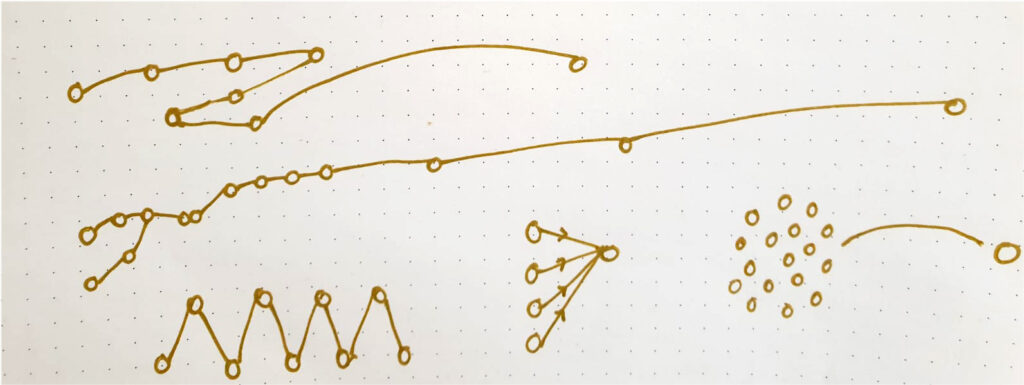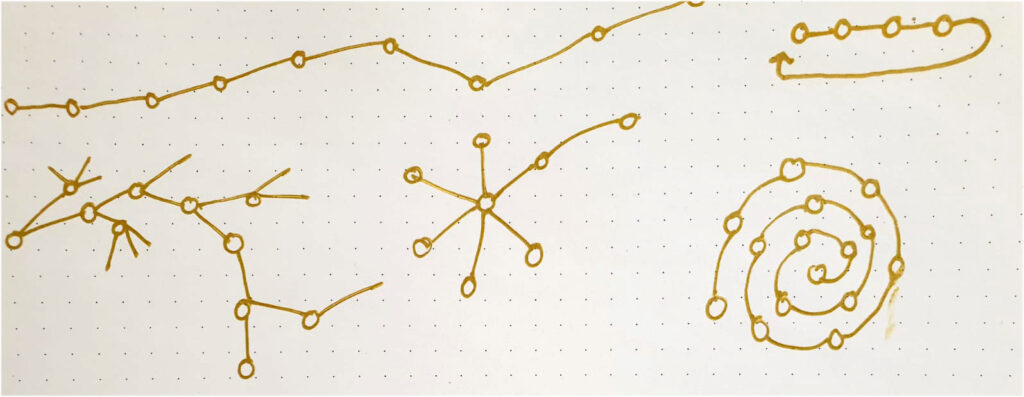This post explores how we might think about progression in art in schools. How can we more carefully define progression in a way that allows and acknowledges the creative journey of the individual?
The most commonly asked questions in our inbox are without doubt:
How do we show progression? When do we introduce the different techniques and materials [in drawing, sketchbooks, painting] and what does progression look like?
We understand the pressure on schools to ask and answer these questions. But we find them SO hard to answer, because when it comes to facilitating art, we think they might be the wrong questions to ask.
Of course, we are wired to aspire to progress. It is a driving force in all our lives, in so many ways. But just as we stepped back to question whether we might pursue knowledge or experience, let’s also step back (or aside) to question how we think about “progression” when teaching art in schools.
Linear Progression in Other Subjects
Progression in other subjects makes sense. In maths for example, we build progression based upon a series of learnt steps and accumulated knowledge. There is an order (or a few different versions of an order) – which allows a child to move forwards through a series of small steps. Areas of learning are revisited, but generally learners are not suddenly “unsure” of knowledge which they felt secure about in a previous year. The process of teaching, and progress of learners, is by and large linear, and this means there can be a clear pathway (or a few clear pathways) to teaching maths. The process of teaching and progress of learners are intrinsically linked.
But can we assume we can apply this idea of linear teaching and linear progression to visual arts teaching and learning?
What Shape is “Progression” in the Visual Arts?
Side Step 1: Let’s Look At How Creative Adults Develop Their Creativity
Since AccessArt’s inception, a guiding light in our practice has been to look at how creative adults nurture their own creativity. What can we learn from the way more experienced practitioners enable their own creativity and how they come to understand their creative process? What insight can we then apply back down the chain to children, teenagers, young people and life long learners, and their respective creative enablers, to help them reach their creative potential?
Let’s see what a typical creative journey might look like – the journey of an artist over a period of a year for example. Take a look at this list of emotions, actions and states of being (presented in no particular order, just as they occur):
Think, test, feel, search, mess, order, ricochet, learn, serendipity, logical thought, copy, interception, reflection, accident, enlightenment, glimmer, instinct, see, envy, inspiration, mess-up, optimism, failure, listen, switch, risk-taking, despair, revisit, lose your way, share, euphoria, steal, reappropriate, misunderstand, build skill, deconstruct, find your voice.
Let’s take a moment to recognise what an extraordinary and evocative list that is. And yet most creative practitioners would recognise at least elements of the journey described. It’s also an entirely “human” list – those words could apply to life as much as art.
What is it not?
It’s not linear. It’s not an a – b, b – c, c – d type of journey. Creative practitioners spend a lot of their time spinning on the spot, feeling like they are going backwards, feeling uncertain just after they felt so sure. This is why artists are such brave, optimistic people, because they are always willing to feel their way whilst not knowing, and to be able to go down long dark blind alleys and find their way back out again into the light.
So if that’s what the journey of a creative adult looks like, we see how it is unlikely it is for us to enable children and teenagers to reach their creative potential if we try to force their learning into a tidy, linear process/progression.

Side Step 2: What Do We Mean By “Progression”?
The word “progression” is used in school closely along with “assessment”, so we need to start to unpick expectations of what a child a) might experience in an art lesson (what materials and techniques they might use) and b) what level they “should” work at. Let’s unpick those before we redefine how we can look at progression in a fluid and helpful way (i.e. non linear).
When The Word “Progression” Is Used To Imply: “What Should We be Doing When?”
We get asked: “When is it appropriate to introduce a child to cross hatching?” We would invert that. When is it not appropriate to introduce a child to cross hatching? (answer: it is always appropriate). Show a four year old how to cross hatch and watch them cross hatch. Their experience and the outcome will be different to that of a twelve year old – but not just because of their age – also because of the context, the weather, the drawing surface, their mood and many other variables.
Progression in the visual arts should not be based upon a proving of yourself before you are allowed to go to the next step. At school, we graduated to a biro handwriting pen after we had demonstrated “sensible” use of a pencil. Let’s not do that to our children in art. Let’s give them access to as much as possible, as soon as possible, and let’s keep giving them the access, in new and old contexts so that they can be re-inspired and re-visit.
Of course there are materials, processes and concepts better suited to older children (oil paints, printmaking with large presses), but these are actually smaller in number than you might think. For the most part, we advocate giving as much access to a wide variety of materials, processes and ideas as soon as possible to all children. Why? Because the creative process is not linear and neither is progression. A child may fly with oil pastels in yr 2, and the same child not fly with oil pastels in yr5. They may love making in years 1 to 5 and then in yr 6 they may draw, draw, draw. In yr 1 to 1 they may paint their whole time, in yr 5 they may lie fallow (brew), and in yr 13 they may return to painting. Autumn term might be a time of experimentation, spring term a term of fallow, summer term a term of discover.
So the answer to the question: Pls can you provide a list of when we should introduce various techniques/materials to a pupil in yr x, would always be “as soon as possible”. Pick a materials or activity you think they would like, and provide that opportunity, and see what happens. There isn’t a linear journey (there are too many potentially exciting materials and ideas to explore) – just don’t underestimate what your pupils can do, and how they will respond.

When The Word “Progression” Is Used To Imply: “Were Should A Child Be At and How Can We Show They Have Developed?”
In subjects with a more linear teaching process, there can be a more “tidy” progression, and we are able to measure progress via tests or other forms of assessment. The child starts at A takes some steps through to B, C, D and gets maybe to Z, and there is an “agreement” amongst teachers which measures these “steps” against “age” and comes up with ability.
This can become dangerous in the visual arts. If the journey is not linear, and we pick a point to assess (end of term for example) how are we able to assess that point in time? Have we caught a child at the end of yr 3 who is on a spiralling journey, or a zig zag journey, or a temporarily backwards journey? Did they just not “get on with” oil pastels but had they been given the opportunity to make they would have excelled? Has the teacher missed an opportunity to talk to the child who instead of following what the rest of the class did, went on to do his own thing, but was too quiet or reticent to share his thinking. Creativity is not as tidy as maths, and never should be. Couple that with the fragility of the creative process and an ego which can be destroyed by judgement and you can see the danger. It would be fine if we could accept every child is on their own unique creative journey which we will facilitate and not assess. But many find that hard in our system.
Lenses
Instead perhaps it is more helpful if we try to see progression in the visual arts in school via some simple lenses which we can aspire to enabling in all our children. These focus on the experience of being creative – if we get these right the skills follow.
Is the child exploring (and within that, are we giving them the best possible opportunity to explore). If they are, let’s see and hear how that exploration is going. If they are not, let’s think why not. Is it because the opportunities aren’t there, aren’t right for them, or for another reason that we can address.
- Is the child given permission to own his/her journey? This means celebrating diversity, and diversion from.
- Is the child helped understand the creative process? The ups and downs, the solutions? Building self-knowledge in this area at primary and secondary school will impact that person through out their life.
- Can the child share journeys and outcomes, at some level, in ways which are right for that child.
- Does it bring the child pleasure and reward? Are they fed by the activity?
So remember, the process of teaching art, and the progress made by learners, is rarely linear. Nor does every child go on the same journey at the same time. Progression may be a spiral, a starburst, a zigzag. Look again at the list of emotions, actions and states above. Ideally we need to allow space for as many of those as is possible – helping the child through the creative process. Or if that list feels too much right now, then aim for creating space for opportunity, exploration, experience and discovery.
What Might This Look Like In Practice? Make It Tangible…
We know that schools with class sizes of 30, often taught by non-specialist teachers, can’t quite cope with the chaos of the adult creative journey.
But that doesn’t mean that instead we have to shoehorn teaching art into the model of linear progression.
To help schools better understand how they might think about progression in the visual arts, and to help them think about how they can provide pupils with rich, creative, open-ended journeys, AccessArt has worked with key practitioners to pathways or “journeys” which give teachers the practical advice and resources they need to underpin visual arts development in their school:
The Drawing Journey
The Sketchbooks Journey
The AccessArt Primary Art Curriculum
In 2022 AccessArt launched a new Primary Art Curriculum. We wanted to create an art curriculum which would help primary schools deliver a really exciting, rich and forward thinking visual arts education, whilst at the same time giving non-specialist and often inexperienced teachers the support they need to feel confident and happy teaching art.
Find out more about the AccessArt Primary Art Curriculum.
